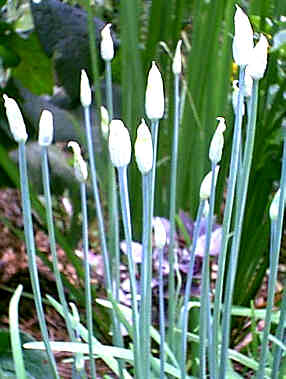
Plant Description
Caution & Interaction

Latin (botanical) name:
Allium sativum
Common names: Garlic, Poor Man's Treacle
Plant Description: Garlic has long, flat, narrow leaves. They are greenish-gray in color and grow to about 12 inches long and 1 inch wide. A round-stemmed flower stalk originates from the center of the plant and produces a ball-shaped, compact collection of white flowers that are sometimes tinged with lavender. The bulb (the only part eaten and the part used for medicinal purposes) multiplies during the growing season, producing highly flavored bulblets called cloves. Each group of cloves comprises a bulb and is wrapped in a white papery sheath. Some varieties have a reddish or purplish sheath. Garlic is ready to harvest about 6 months after planting when the flowers are fading and the leaves begin to turn yellow and shrivel.
Medicinal Properties &Uses: It has been known for quite some time that garlic is a natural immune system enhancer. The active properties, sulphur compound allicin, ajoene, allyl sulfides, and vinyldithiins, help the body fight off infections and bacteria. Garlic is also known to enhance the body's immunity from colds and flu. It has been proven effective in lowering blood pressure and reducing cholesterol. The active ingredient allicin is effective in helping to promote proper circulation throughout the body. Garlic can drop the level of cholesterol in the blood by 15% when taken for 2 months or more. When Garlic is taken as a supplement and combined with a positive diet change, blood cholesterol levels can drop enough to reduce heart attack risk by 30%. Studies have confirmed that garlic is effective against bacteria, yeasts. and fungi. Garlic can be safely taken for mild, recurring or chronic infections which are not dangerous such as infections of the mouth, ears, throat, colds, and especially candida. Other benefits to using Garlic are stress reduction, blood purification, and anticoagulant effects.
Dosage: 15-40 drops in water or juice, 2-3 times daily, or as needed. Shake well before using.
Cautions & Interactions: Do not take while nursing. Keep out of reach of children.
Efficacy Studies & Other Clinical Data: Helpful Links:
Disclaimer (U.S. Only): These statements have not been evaluated by the FDA. These products are not intended to diagnose, cure, treat, or prevent any disease.
Common names: Garlic, Poor Man's Treacle
Plant Description: Garlic has long, flat, narrow leaves. They are greenish-gray in color and grow to about 12 inches long and 1 inch wide. A round-stemmed flower stalk originates from the center of the plant and produces a ball-shaped, compact collection of white flowers that are sometimes tinged with lavender. The bulb (the only part eaten and the part used for medicinal purposes) multiplies during the growing season, producing highly flavored bulblets called cloves. Each group of cloves comprises a bulb and is wrapped in a white papery sheath. Some varieties have a reddish or purplish sheath. Garlic is ready to harvest about 6 months after planting when the flowers are fading and the leaves begin to turn yellow and shrivel.
Medicinal Properties &Uses: It has been known for quite some time that garlic is a natural immune system enhancer. The active properties, sulphur compound allicin, ajoene, allyl sulfides, and vinyldithiins, help the body fight off infections and bacteria. Garlic is also known to enhance the body's immunity from colds and flu. It has been proven effective in lowering blood pressure and reducing cholesterol. The active ingredient allicin is effective in helping to promote proper circulation throughout the body. Garlic can drop the level of cholesterol in the blood by 15% when taken for 2 months or more. When Garlic is taken as a supplement and combined with a positive diet change, blood cholesterol levels can drop enough to reduce heart attack risk by 30%. Studies have confirmed that garlic is effective against bacteria, yeasts. and fungi. Garlic can be safely taken for mild, recurring or chronic infections which are not dangerous such as infections of the mouth, ears, throat, colds, and especially candida. Other benefits to using Garlic are stress reduction, blood purification, and anticoagulant effects.
Dosage: 15-40 drops in water or juice, 2-3 times daily, or as needed. Shake well before using.
Cautions & Interactions: Do not take while nursing. Keep out of reach of children.
Efficacy Studies & Other Clinical Data: Helpful Links:
Disclaimer (U.S. Only): These statements have not been evaluated by the FDA. These products are not intended to diagnose, cure, treat, or prevent any disease.